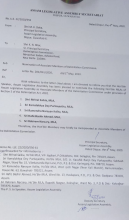The use of Muga and eri silk is quite closely associated with the culture of Assamese society and occupies a unique place in the socio economic life of the people of Assam. It is not possible to ascertain correctly the exact nature of how weaving was first introduced in Assam but in the olden days every Assamese house reverberated with the shuttles of looms and each and every women of Assam knew the art of weaving. Men folk in those days only wore those clothes which were woven by their mothers, wives or sisters. This may be attributed to the patriotic bent of the people of Assam in olden days and also deliberate measure by the government at that time for it was obligatory on the part of every Assamese household to contribute to the royal stores one seer of home spun silk annually. Today the name and fame of Assamese silks have spread far and wide and tourists make it a point to take home a sample of these woven magic. But sadly today due to the shortage of Muga silk yarn about 3,000 muga sector handlooms are depending on the cheap Chinese tassar yarns. According to scientists of the Central Silk Board (CSB) SN Mishra, there are about 50 kgs of muga yarn annually. Assam produces around 100 MTs of raw Muga silk yarn annually. With such a quantity of raw muga yarn, only 2,000 handlooms can be operated therefore the operators are left with the other alternative, that is the Chinese silk which is available in much cheaper rates as low as 1,500 per kg, against Rs 4,500 of muga yarn. Prohibition of this practice at present is not a solution as it would be damaging for the people engaged in these looms. The government should aim for higher production of muga yarn in order to keep these weavers employed and only then think of reducing the use of Chinese silk.Depending on the chinese yarn which is far inferior than the indigenous one will only diminish the muga legacy of Assam. The Assam government and the CSB plans to produce 250 MTs of muga silk yarn and 1000 MTs of Eri yarn annually by the end of the Eleventh Five Year Plan. The state has around 20,000 commercial silk handlooms engaged in this sector where many are even producing ‘kesa paat’ (raw silk) fabrics.. India is trying to develop bivoltine mulberry silk races for increasing silk production. The chinese invasion in our mulberry sector should be thwarted before it takes over the silk markets. India needs to make this venture a success and hold on to its own muga, undeterred and of course unadulterated
Assam is one of the major producers of tea in India. Since its dicovery in the year 1823 Assam tea has traversed a long distance. Before the commercialization of tea began in Assam, the leaves of the tea plant were chewed by the local villagers with little or no processing. This still continues in certain inaccessible regions of southeastern Assam, as well as in neighboring regions of Myanmar. Robert Bruce is said to be the person who re-discovered the tea plant growing wild in the region at the behest of nobleman, Maniram Dewan and before his death in 1825, Robert passed on his knowledge to his brother Charles, who sent seeds of the plant to Calcutta in 1831.In 1833 the British lost...







Comments
Pages
Add new comment